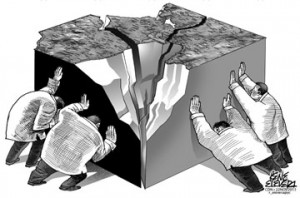
This time, however, there is no threat of nuclear war or self-inflicted human annihilation. The clear and present danger is from severe storms spawned by climate change that could be more frequent and powerful.
Yolanda is a portent of things to come, says Kristalina Georgieva, a member of the European Commission (EC) and head of the EC International Cooperation, Humanitarian Aid and Crises Response.
“We have to be ready to live in a world where megastorms happen more often,” she said. In order to adapt, the challenge is “to build better by making buildings stormproof.”
Yolanda has affected 13.25 people and displaced 4.4 million. The United Nations World Food Programme which provides basic food, like power biscuits, said two days ago that up to 600,000 people are going hungry especially in Leyte and Eastern Samar.
The country’s two biggest military air bases, Villamor Airbase in Metro Manila and the Benito Ebuen Airbase in Mactan, have been operating at maximum air traffic with cargo planes from all over the world bringing in relief goods for Yolanda survivors. The US Navy’s George Washington aircraft carrier group is back in Leyte Gulf to speed up the distribution of relief goods.
The global humanitarian effort is healing the hearts of Filipinos broken by Yolanda. But soon, when we start getting back on our feet, the donors will leave us to handle the arduous task of rebuilding our communities.
Yolanda’s wrath makes the ongoing UN Climate Summit in Warsaw, Poland very relevant. It’s sad that negotiations on proposals for a mechanism to obligate countries to commit funds, technology and capability building to address climate change related loss and damage in developing countries is going down the drain. The G77 countries or the group of 132 developing countries walked out of the negotiations last Wednesday.
With this development, the Philippines has to realize that we are on our own in preparing for megastorms.
In the last five years, the country was visited by four of them: Ondoy (Ketsana) submerged Metro Manila in September 2009; Sendong (Washi) in Northern Mindanao in December 2011; Pablo (Bopha) claimed around 1,200 lives in Southeastern Mindanao in December 2012.
While we thank the global community for rushing to our aid, what is needed are steps to mitigate the inevitable impact of calamities on a global scale.
This includes drastic carbon emission cuts by the developed world, especially China, and finance schemes to enable vulnerable cities and countries like the Philippines to adapt to megastorms, droughts and creeping sea level rise.
In the words of Philippine Climate Change vice chairperson Lucille Sering before the Warsaw walkout: Loss and damage is not compensation but prevention.”